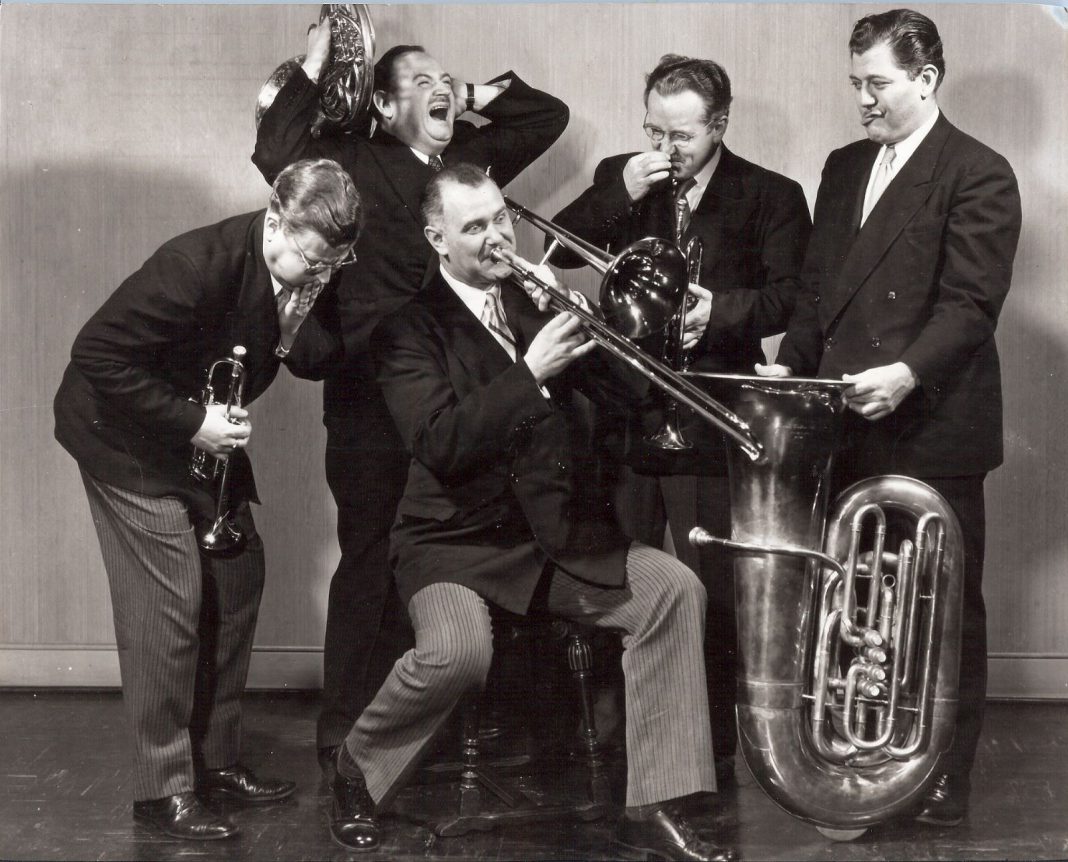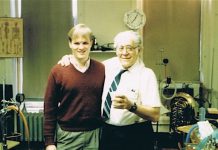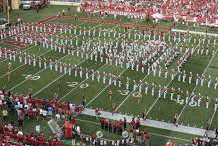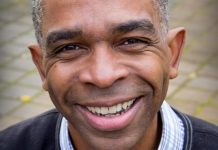(First published in the International Tuba Euphonium Journal, Fall 2015 Issue)
By Frank Byrne and Michael Grose
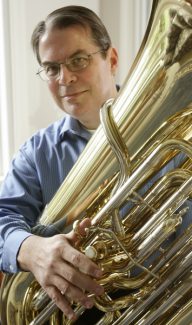
The 100th anniversary of Arnold Jacobs’ birth provides an opportunity to remember and re-examine his legacy. Marking a centenary also risks placing Jacobs in a mythic status like that of golfing legend Ben Hogan. If the reader asks “Ben who?” then you know what the authors have experienced in speaking to audiences who never studied with, much less heard Arnold Jacobs perform with the Chicago Symphony. Is the Jacobs legacy nostalgia or urban myth? The answer is no.
Our media-dominated culture worships the new and, in so doing, trivializes the past. One could imagine Arnold Jacobs being categorized with a giant like Thomas Edison — revered but not terribly relevant. In fact, Arnold Jacobs was a visionary and groundbreaking teacher and performer. He was to his musical peers as Tesla was to Edison. He was decades ahead of his time in his musical philosophies, and he helped transform how to make and understand music.
Arnold Jacobs understood people in their humanity, their physiology, and – most importantly – their musical mind. While science has taken quantum leaps in the past century, human beings are still “wired” similarly and their body systems still function in the same way. The teachings of Arnold Jacobs are as relevant today as they were in the 1960s when his teaching took off – even more so because Jacobs was very advanced in his application of techniques that have come to be understood as integral to training and re-mapping the brain.
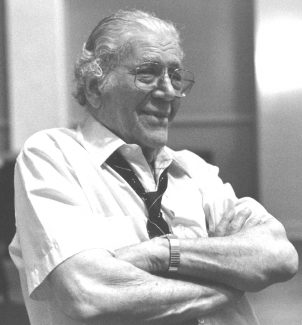
All attempts to capture the essence of Arnold Jacobs (including this article) are limited because there was not a single Jacobs “method” that can be packaged and boxed for our convenience. Phrases like “song and wind” are only part of a larger picture. Arnold Jacobs was not about slogans, or gadgets, or even about York tubas and breathing. Jacobs was about one thing only: MUSIC. He knew that it was the musician who plays the instrument, often described by him as a “stupid piece of brass that has no brain.” The instrument is a tool of expression and the body an animating mechanism to create the vibration that is resonated in the instrument. But all this begins in the brain, and it is here that Jacobs had the ultimate revelation that made him unique. There had first to be a compelling musical message in the mind of the musician.
His most rudimentary precepts are incredibly profound. He did not want us to discuss being a brass “player” lest it imply that we were technicians operating a machine. He wanted us to be musicians, artists, and most of all COMMUNICATORS of music to an audience. His knowledge of physiology and anatomy were encyclopedic, but all placed in service of the art form and the act of communication. He knew it all and could explain it with stunning eloquence, but would be the first to say, “I don’t care whether you do it ‘right or wrong,’ I just want you to sound better than anyone else.”
Northwestern University professor Rex Martin, a longtime Jacobs student, wrote, “Mr. Jacobs had a complete mastery of musical communication. Everything that he worked on with his students was to help them to communicate musical ideas to an audience. As he defined it, this was the psychology of performance. Learning to think like a great artist was the most important step to becoming a great artist.”
Some skeptics have tried to characterize Jacobs’ philosophies as one step above the “think system” of The Music Man’s Professor Harold Hill. Not only are such attitudes ignorant, they miss the essence of what Arnold Jacobs lived to share: Making music can be a great joy if we only get out of our own way. Would you like to experience that joy and play much better with greater ease than ever before? The answer is Arnold Jacobs.
Decades before the power of visualization was embraced at the highest levels of professional sports, Jacobs was preaching the gospel from the basement of his modest home on South Normal Avenue in Chicago. Visualization and the mental aspect of world-class performance began to be known in the 1970s when it was observed in Soviet Olympic athletes, but it now is considered essential among top athletes. World champion golfer Jack Nicklaus said, “I never hit a shot, not even in practice, without having a very sharp in-focus picture of it in my head.” It is this very concept of brain/body connection that Jacobs understood before most others in music.

Jacobs’ studies of psychology revealed that the musical message must dominate, with over 90 percent of mental concentration devoted to the message, and a small fraction to anything else. As performers, we are too often caught thinking about how it feels vs. how it sounds. We become focused internally and the musical message is drowned out because we analyze while trying to perform. Communication to another person is thwarted in our earnest effort to produce the notes. We have become technicians and not communicators.
Arnold Jacobs was a natural musician with great innate talent that cannot be denied. When he learned as a child to play bugle calls by ear, imitating the notes played by his mother on the piano, he began training himself to respond to sound and pitch, not to lip tension. Imitation was one of Jacobs’ most important concepts, for it demanded that there be something to imitate: a musical sound, a performance, or a recording. Consider this simple illustration that you can try: Imitate an accent or dialect using your voice. Maybe it’s a British accent, or a faux-French accent, or a TV personality with a distinctive voice. Just do your best to imitate the sound of that voice. Now ask yourself: How did you do that? You recalled the sound of that accent in your mind, and using your ability to speak altered your voice to try to match that accent or voice you had in mind.
Learning to be a fine musician uses the same methodology, but first demands that we program our brain with superb musical role models. Jacobs would often say, “Play this like Bud Herseth would play it,” or he would take the student’s tuba, demonstrate something, and ask the student to imitate him, or he might sing a phrase with his marvelous, resonant voice and ask you to imitate that. Jacobs heard great music-making from the time he entered the Curtis Institute at 15 years old and was shaped by that, as well as by repeatedly taking the class on phrasing and solfege taught by Philadelphia Orchestra principal oboist Marcel Tabuteau. Jacobs passed the class but took it again every year he was at Curtis to get further steeped in the artistry that was being shared. Jacobs was a brilliant solfege artist who could sing anything, thereby giving him a perfect concept of the pitch he wanted to produce. And beyond pitch, there was a sophisticated concept of the attack, tone color, and every other facet of artistry. Jacobs had a vast musical vocabulary of shading and color in his playing, and it made his tuba playing thrilling.
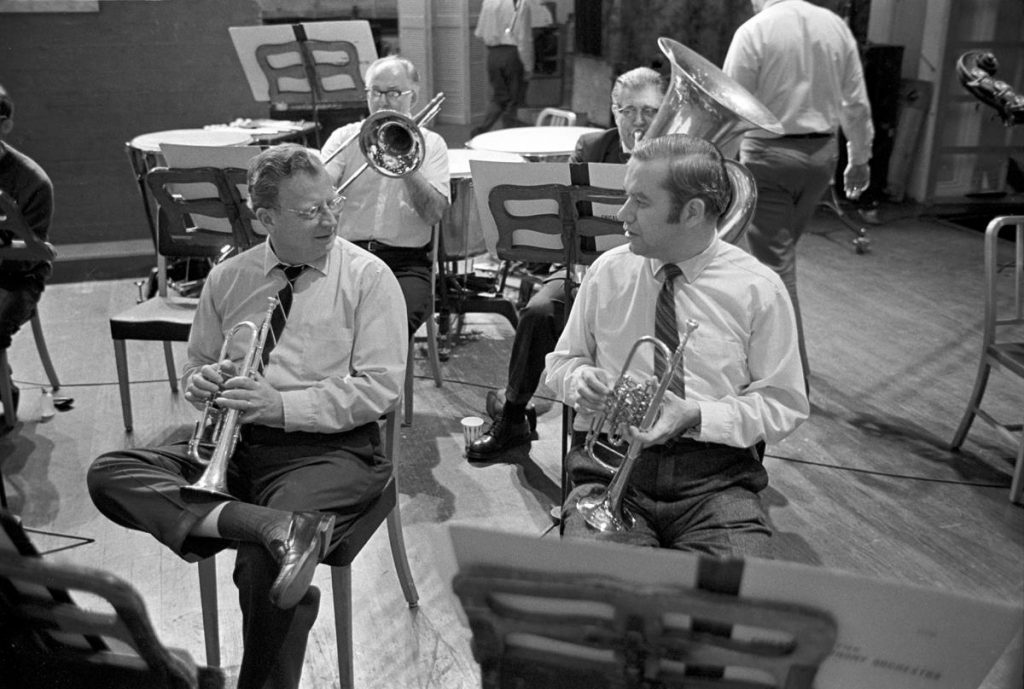
There were and are today many excellent tuba players, but those who know Jacobs’ playing intimately would agree that not only was his playing superb, it was uniformly thrilling – whether hearing him play a simple two-note solo passage in “Also Sprach Zarathustra” or providing the vibrant foundation to massive chords in a Bruckner symphony. It was a spine-tingling, larger-than-life presence that animated the entire brass section of the CSO and thereby the orchestra. Following a performance of Bruckner’s Symphony No. 6 conducted by Rafael Kubelik, one of Bud Herseth’s students commented to Mr. Herseth about how impressed he was by the playing of Arnold Jacobs. Herseth smiled and responded, “It’s like he has his hand in the small of our back, gently urging us forward.”
Jacobs’ consistent high standards and inspiring musicianship earned the admiration of the world’s greatest conductors and his legendary colleagues. The great Fritz Reiner thought Jacobs was the greatest tuba player in the world. Guest conductors of the CSO swooned over his playing and regularly tried to recruit him. Horn virtuoso Philip Farkas said he’d never heard a tuba player like Jacobs, and longtime CSO principal oboe Ray Still considered Jacobs not only one of his musical inspirations but the most important teacher he ever had. Jacobs’ longtime CSO colleague bass trombonist Ed Kleinhammer said that sitting next to Jacobs was “a keyhole view into heaven.”
What generated this great respect and even veneration? It didn’t hurt that Arnold Jacobs was unfailingly kind, patient, and courteous to everyone from a famous player walking into his studio to the elevator operator at the Fine Arts Building, where he had his studio in later years. But aside from the personal aspects of this great man, it was his remarkable and thrilling musicianship that earned the highest accolades.
Jacobs taught hundreds of students over the decades. Students of virtually all wind instruments came to him for guidance, frequently saying that they never played as well or with as much ease as they did in his presence. He had the ability to inspire and get you quickly to focus on your musical message. If there was a physical issue with breathing or tension that was inhibiting the student’s ability to move air, he addressed it away from the instrument using gauges and devices to provide a visual cue. It was both effective and simple: If you control the ball, you are controlling your air. But the emphasis was on moving the ball (the product), not on how you did it.
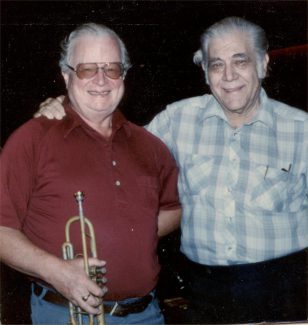
Herein lies one of the great paradoxes of the Jacobs philosophy: It is incredibly simple, but not easy to change long-held habits that hold a player back. Playing a musical instrument, in Jacobs’ lexicon, is a series of conditioned responses developed through a trial-and-error process in response to various stimuli. Most players came to Jacobs with conditioned responses that were getting in their way. They substituted tension and pressure for wind (air in motion). They played by pushing valves vs. conceiving of a clear pitch and sending that into the brass instrument. They substituted moving their body for taking a full, seamless breath. Some people could play in spite of these bad habits, but none reached their potential until new habits were developed over time — NEW conditioned responses developed to a new set of stimuli. Jacobs’ concept of teaching not by breaking old habits but replacing them with new, better habits was an early musical application of what we know today as neuroplasticity.
Science has affirmed that the human brain can reorganize itself by forming new neural connections as a result of experience. These changes happen by learning a new way of thinking about and doing something – such as taking a breath – and creating a new, better habit. Want to take a full breath? Jacobs advised to simply suck air at the lips and let it go where it will. Suction without friction is the correct cue to motivate a good breath vs. making a shape change in the body. Trying to play with inadequate air created its own set of tensions and made a full, resonant sound impossible.
Through careful practice and repetition, the new way would eventually replace the old habit and create a new conditioned response and a new pattern of neuronal activity. One of Jacobs’ frequent comments was, “Don’t correct what’s wrong, go for what’s right,” and this was reinforced by urging students to rehearse success and not failure in practice. Dr. Frank Diaz, a music educator who has written numerous scholarly articles on the psychology of music, said, “Jacobs’ notions on creating new habits rather than erasing old ones, and on using top-down approaches (mind controls meat) as a way of creating these new neural maps were insightful.”
Jacobs met each student where he or she was, and adapted his teaching techniques to whatever that student needed most. There was no single, immoveable “Jacobs method,” and for that reason he resisted writing a textbook. Of course there were common problems that presented themselves, but how he addressed them and the words and images he used with each student were unique.
Jacobs’ teaching was not magic or new-age mysticism. It was a scientifically-based, musically-oriented, and eminently practical way to allow people to realize their potential as musicians. And while the techniques varied student-to-student, what did not vary was the imperative for quality at all times: quality in tone, intonation, interpretation, and telling a story with music. Notes were not enough. There had to be a story, a narrative expressed via the music. The musical line had to go somewhere, and for that reason he demanded that even simple exercises in the Arban book be played with a musical direction. Whatever it was, the emphasis was on quality.
Jacobs calibrated his musical demands to the ability of the student. If he had to begin with whole and half notes, they would be the finest whole and half notes with wonderful tone, perhaps in a Bach chorale or a great hymn. With repetition over time, excellent new habits would be built as a foundation for more sophisticated music, slowly developing the art form note by note. And he advised, “Don’t practice, always perform.” Jacobs said, “You should engage in the deliberate act of story-telling each day you practice.” Make it mean something.
Asking a brass player to play on the mouthpiece would not only upset old habits and reorient the thinking, but would immediately solidify the connection between the pitch in the head and the pitch in the buzz, exposing a disconnect not as evident with the mouthpiece in the horn. Encouraging his students to play very familiar melodies on the mouthpiece assured there was a strong musical stimulus guiding the buzz. There was no doubt that the student knew the tune to “Happy Birthday,” so he might start there. With that clear mental image of the melody, by trial and error the student learned to play that simple tune on the mouthpiece with accuracy and clarity, building new and more productive habits. At the same time, the student began moving much more air, and tension in the torso went away. Over time, more complicated songs and even solos could be buzzed. Jacobs said that the horn was only a big megaphone that amplified and colored the buzz that was being sent in, so he encouraged students to get the finest sound on the mouthpiece alone. This redirection of focus put the attention on pitch, sound, and music without the student being aware of what was happening.
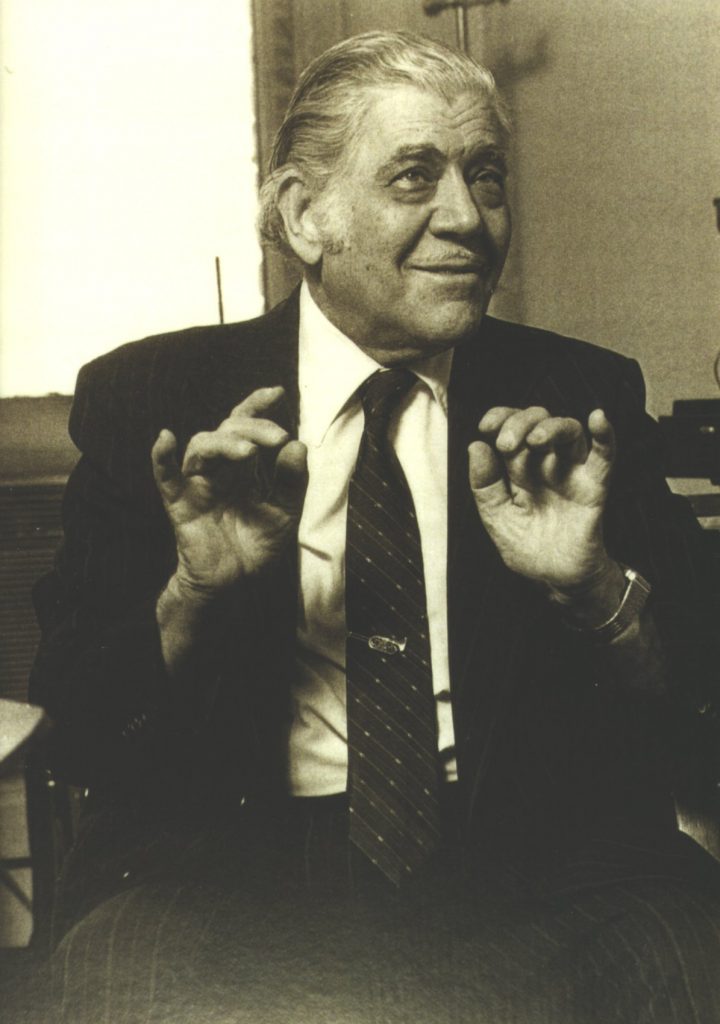
It was genius. Through his study of medicine and psychology, Jacobs knew how to put the emphasis where it belonged: on developing the musical mind of the player. He knew how to teach change in form or function through music, not vice versa. If something needed to improve in the physical act of playing, there was always an aural motivation. With articulation, it was done with speech. If with another factor, he would assign a musical challenge that would create the physical response. If you needed to evaluate your playing, record it and listen to it later, putting a wall between the acts of making statements (performing) and asking questions (evaluating). Jacobs did the same in his own practice by recording himself frequently.
Jacobs died in 1998, a decade after retiring from his 44-year career in the Chicago Symphony. He left huge musical shoes to be filled, and no one understood this better than Gene Pokorny, who said upon being offered the job, “Nobody ‘replaces’ Arnold Jacobs.” If the reader imagines that the Jacobs legacy is hagiography or has been enlarged in death, it is not true. He can be sincerely appreciated even with knowledge of his humanity. He was not always very organized in his personal life. Remarkably dedicated to his wife, Gizella, he said that he should have devoted more time to his son. How many other parents might echo his words? The physiology and psychology of music became his job, his hobby, and his obsession, but there are also countless examples of his kindness and personal generosity to so many of his students, not to mention neighbors and friends. He cared about people and had a positive disposition that brightened the lives of those he knew. We can understand his complexity while still giving all respect and credit for his revolutionary approach to music.
Arnold Jacobs was a marvelous musical role model who can continue to inspire for generations to come. His teaching left an indelible mark on many whose lives he changed. Through his many great CSO recordings, we get a glimpse of his amazing artistry that, if we could magically hear it live again today, would thrill and motivate us even more. His greatest legacy, and the one that would please him the most, is that we aspire to his level of excellence in music and – most importantly – that we capture and emulate the joy that he radiated in every note.

